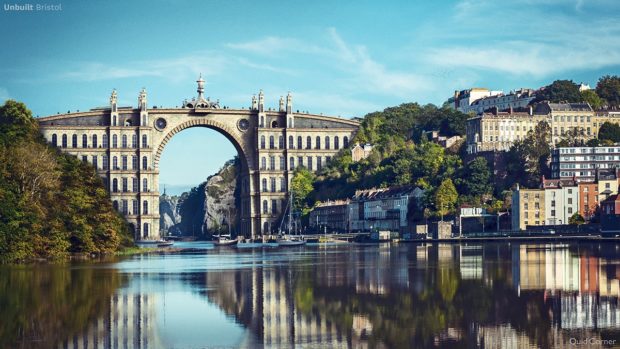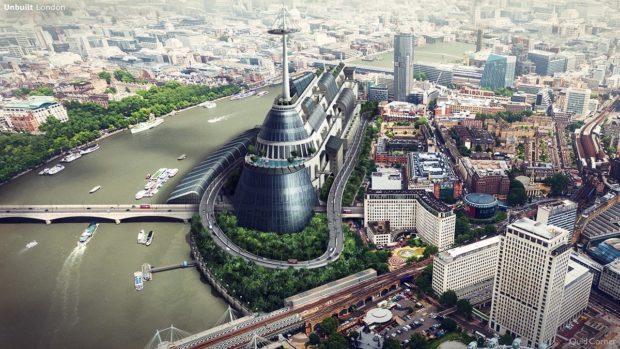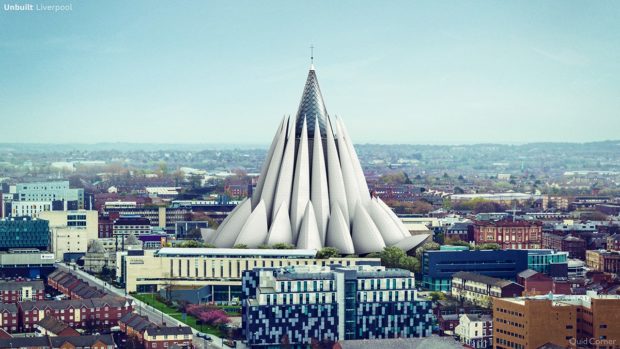The best laid plans, eh? Everybody has big ideas about buying their dream home or redesigning and decorating the place they live. But without the get-up-and-go – or the cash – these plans often drift away, unused, through the dusty canyons of your mind…
It’s disappointing, but you can always come back to your ideas when conditions are better. Spare a thought for the architects and city planners who wanted to give entire cities a new look, but never got the go-ahead.
That’s just what the folk at Quid Corner decided to do. In fact, they went to the effort of creating new renderings of landscape-changing proposals for six British cities – none of which saw the light of day.
Let’s take a look at those faded dreams!
Bristol
William Bridges took his given name so seriously that he devoted his life to water crossings. And in 1793 he revealed plans for a bridge like no other, almost a city in itself stretching across the Avon Gorge in Bristol.

Bridges’ big – very big – idea was for his overpass to be supported by six storeys of interior rooms, including a corn exchange, chapel, tavern, museums, market, library, and even stables! This way the bridge could pay for itself, which was a smart solution since the city had rioted over proposed tolls earlier in the year.
But the cost of those riots and of the French revolution meant purse-strings were tight. Bridges’ bridge never bridged the Avon, and Brunel finally got to build on the site seven decades later.
London
They love a mad-looking building in London. The Shard, Gherkin, and Walkie-Talkie were almost joined by the Dougal: a cultural building more or less the shape of the drop-eared Skye Terrier from The Magic Roundabout.

Designed by Sir Misha Black and Hilton Wright, the building was intended to commemorate the 1951 Festival of Britain, but lost out to the rather drab building that we now know as The Royal Festival Hall.
Liverpool
At least Liverpool had the guts to swap one crazy design for another. There were two key entrants to the 1959 contest to design a new Catholic Cathedral for the city. C.H.R. Bailey’s “icing-bag nozzle” was a space-age tower resembling some kind of alien houseplant.
But it lost out to Paddy’s Wigwam, a more regal-looking and only moderately less odd fixture on Hope Street that, to look at, is both a product of its time and an outlandish piece of architecture somehow impossible to imagine any other way.
Manchester
Manchester’s Piccadilly Gardens are the portal to the city for anyone visiting by train or bus. But they’ve long been a source of embarrassment to locals, as the city has trialed gray border-style walls, gaudy takeaway joints, and the hideous Number One Piccadilly Building in an attempt to exploit the strange psychogeography of the place.
An honest old classical gallery might have done the job better. But E. Berry Webber’s interwar plans for an art space that doubled as a memorial to the WWI infirmary that stood there before could not withhold the pressure of the period’s harsh economy.
Newcastle
Despite glimpses of character and innovation, Newcastle isn’t known for its inspirational architecture or green spaces. That could have been different had plans to build a network of garden walkways throughout the city center been realized.
It’s an idea that now seems ahead of its time, but sadly it was dragged down by the economic conditions of the day, including a culture of corruption among the high and mighty of North East England.
Edinburgh
In Edinburgh, a new 164ft-high keep for the famous castle would have dramatically altered the way the city looks.
David Bryce sketched the imposing new structure as a proposed memorial for Prince Albert in 1862. But it was vetoed by Queen Victoria, Albert’s widow, and only the drawings remain – allowing Quid Corner’s designers to imagine how it would have made the city look today.
Which city would you like to see given a new focal point?

